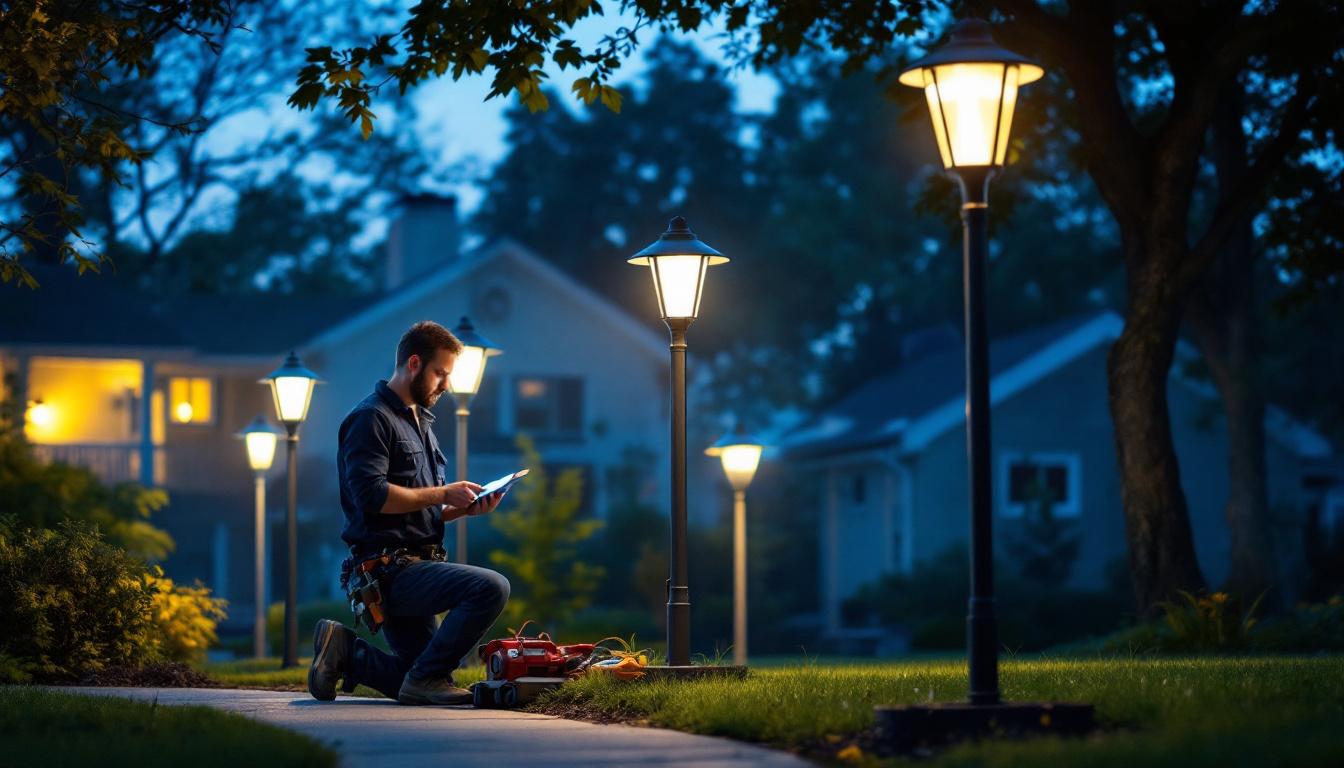
In the world of lighting design and installation, wall outlets play a crucial role in ensuring that fixtures function correctly and efficiently. For lighting contractors, understanding the intricacies of wall outlets is essential to avoid costly mistakes that can derail projects and impact client satisfaction. This article will explore common pitfalls in wall outlet installation and provide valuable insights to help contractors navigate these challenges effectively.
Before diving into the potential mistakes, it’s important to grasp the fundamental aspects of wall outlets. These outlets provide the necessary electrical connections for various lighting fixtures, including recessed lights, wall sconces, and pendant lights. Understanding the types of outlets and their configurations is essential for any lighting contractor. The role of wall outlets extends beyond mere functionality; they are integral to the overall design and safety of a space, ensuring that electrical systems operate efficiently while also complementing the aesthetics of the interior.
Wall outlets come in various types, each designed for specific applications. Standard outlets are the most common, typically used for general lighting. However, specialized outlets, such as dimmer switches and GFCI (Ground Fault Circuit Interrupter) outlets, are crucial for specific settings, especially in areas prone to moisture. GFCI outlets are particularly important in bathrooms and kitchens, where water exposure increases the risk of electrical shock. These outlets monitor the flow of electricity and can cut off power if an imbalance is detected, providing an essential layer of safety.
Additionally, smart outlets are becoming increasingly popular, allowing for remote control and automation of lighting systems. These innovative devices can be integrated with home automation systems, enabling users to control lighting via smartphones or voice commands. Familiarity with these different types will enable contractors to make informed decisions when selecting outlets for their projects. Furthermore, understanding the compatibility of smart outlets with existing electrical systems is crucial, as it can influence the overall efficiency and performance of the lighting setup.
Correct placement and spacing of outlets are vital for both functionality and aesthetics. Outlets should be strategically located to ensure that they are easily accessible and do not interfere with the overall design of the space. For instance, placing outlets too high or too low can create an awkward appearance and may limit the types of fixtures that can be used. In addition to visual considerations, practical aspects such as furniture placement and the intended use of the space should be taken into account. For example, in a living room, outlets should be positioned near seating areas to facilitate the use of lamps and electronic devices.
Moreover, adhering to local building codes regarding outlet spacing is essential. These codes often dictate how far apart outlets should be placed, especially in residential settings. Ignoring these regulations can lead to code violations and potential fines. Additionally, proper spacing can enhance safety by reducing the risk of overloading circuits. It’s also worth noting that the National Electrical Code (NEC) provides guidelines that can help contractors determine the optimal number of outlets for different rooms, ensuring that homeowners have sufficient access to power without compromising safety or design integrity.
Even experienced contractors can make mistakes during the installation of wall outlets. Recognizing these common errors can help prevent costly rework and ensure a smooth project flow.
One of the most significant mistakes is failing to calculate the electrical load adequately. Each outlet has a maximum load capacity, and exceeding this limit can lead to circuit overloads, tripped breakers, or even electrical fires. It is crucial to assess the total wattage of all fixtures connected to an outlet and ensure that it does not exceed the recommended limits.
Contractors should also consider the cumulative load of multiple outlets on the same circuit. Proper load balancing is essential to maintain safety and functionality in lighting systems.
Choosing the wrong type of outlet for a specific application can lead to various issues. For instance, using a standard outlet in a damp area, such as a bathroom or kitchen, can pose serious safety risks. GFCI outlets should be used in these environments to protect against electrical shock.
Furthermore, failing to install dimmer switches where needed can limit the functionality of lighting systems. Contractors should assess the requirements of the project and select the appropriate outlets accordingly.
Wiring techniques are critical in ensuring that wall outlets function correctly. Improperly wired outlets can lead to flickering lights, inconsistent power supply, and even electrical hazards. It is essential to follow best practices for wiring, including using the correct gauge wire and ensuring secure connections.
Contractors should also be mindful of the polarity of connections. Incorrectly wiring outlets can result in reversed polarity, which can damage lighting fixtures and pose safety risks.
To avoid the mistakes discussed above, lighting contractors should adopt best practices for wall outlet installation. These practices not only enhance safety but also improve the overall quality of the lighting project.
Planning is the cornerstone of a successful lighting project. Before installation, contractors should conduct a comprehensive assessment of the space, considering factors such as the layout, intended use, and client preferences. This planning phase should include detailed schematics that outline the placement of outlets and the types of fixtures to be used.
Additionally, discussing the project with clients can provide valuable insights into their needs and preferences, ensuring that the final installation meets their expectations.
Compliance with local building codes and regulations is non-negotiable. These codes are designed to ensure safety and functionality, and failing to adhere to them can result in significant setbacks. Contractors should familiarize themselves with the relevant codes in their area, including those related to outlet placement, load capacities, and wiring techniques.
Regularly consulting with local building authorities can also help contractors stay updated on any changes to regulations, ensuring that their work remains compliant.
The quality of materials used in wall outlet installation directly impacts the longevity and safety of the lighting system. Investing in high-quality outlets, wiring, and connectors can prevent future issues and enhance the overall performance of the lighting fixtures.
Contractors should prioritize reputable brands that meet industry standards. While it may be tempting to cut costs with cheaper materials, this can lead to more significant expenses down the line due to repairs or replacements.
Once the installation is complete, thorough testing is essential to ensure that all outlets function correctly. This step can help identify any issues before the project is finalized and handed over to the client.
Functional testing involves checking each outlet to ensure that it provides power to the connected fixtures. This process should include testing for proper voltage levels and ensuring that there are no flickering lights or intermittent power issues. Using a multimeter can help contractors measure voltage and identify any discrepancies.
Additionally, testing GFCI outlets is crucial to ensure that they trip correctly when exposed to moisture or faults. This safety feature is vital in preventing electrical shocks and should never be overlooked.
If issues arise during testing, contractors should have a systematic approach to troubleshooting. Common problems may include tripped breakers, flickering lights, or outlets that fail to provide power. Identifying the root cause of these issues is essential for effective resolution.
Contractors should check for loose connections, damaged wiring, or overloaded circuits. In some cases, consulting with a more experienced electrician may provide additional insights into resolving complex issues.
Once the installation is complete, educating clients about the proper use and maintenance of wall outlets is essential. This knowledge empowers clients to make informed decisions regarding their lighting systems and helps prevent misuse that could lead to issues down the line.
Clients should be informed about the safety features of their wall outlets, especially if GFCI or smart outlets are installed. Understanding how these features work can help clients appreciate their importance and encourage them to utilize them effectively.
For example, explaining how GFCI outlets protect against electrical shocks can instill confidence in clients regarding their safety. Providing written instructions or guides can also serve as a helpful reference for clients.
Regular maintenance is key to ensuring the longevity and functionality of wall outlets. Contractors should advise clients on how to inspect outlets for signs of wear or damage and encourage them to report any issues promptly.
Additionally, educating clients on the importance of not overloading outlets and using the correct wattage for bulbs can help prevent potential hazards. Providing tips on how to care for outlets can foster a sense of responsibility among clients, ultimately leading to better outcomes for their lighting systems.
Wall outlets are a fundamental component of any lighting project, and understanding their proper installation and usage is crucial for lighting contractors. By recognizing common mistakes, adhering to best practices, and educating clients, contractors can avoid costly errors and enhance the overall quality of their work.
Investing time in planning, compliance, and quality materials will pay off in the long run, leading to satisfied clients and successful projects. As the lighting industry continues to evolve, staying informed about the latest trends and technologies will further empower contractors to deliver exceptional results.
Ready to elevate your lighting projects with superior products that promise both quality and value? Look no further than LumenWholesale. Our extensive range of spec-grade lighting products is designed to meet the highest industry standards, ensuring you deliver flawless installations every time. With unbeatable wholesale prices and the convenience of free shipping on bulk orders, you can trust LumenWholesale to provide the best lighting solutions without the burden of inflated costs. Say goodbye to middleman markups and hello to reliability and performance. Wholesale Lighting at the Best Value is just a click away. Make the smart choice for your lighting needs today.

Discover how cutting-edge lighting technology is revolutionizing the industry and driving success for lighting contractors.

Discover how a 20 amp rocker switch can revolutionize your lighting installation projects with enhanced efficiency and safety.

Explore the essential guide for lighting contractors as we delve into the most frequently asked questions about light post covers.

Discover why troffer lights are essential for any successful lighting project.